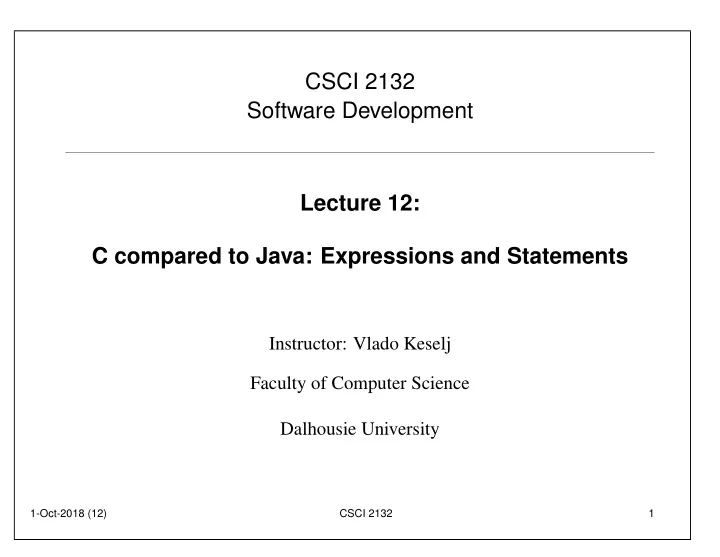

CSCI 2132 Software Development Lecture 12: C compared to Java: Expressions and Statements Instructor: Vlado Keselj Faculty of Computer Science Dalhousie University 1-Oct-2018 (12) CSCI 2132 1
Previous Lecture • Processes and programs – threads – process Control Block (PCB) • Process creation – fork and exec system calls • Job control and process control – foreground and background processes – commands for managing jobs and processes 1-Oct-2018 (12) CSCI 2132 2
C Operators, Expressions, and Statements • We assume that you know Java well • Focus on differences between C and java • Arithmetic Operators • Similar; e.g,, + , - , * , / , % , ++ , -- , = , += . . . • % cannot be applied on floating-point numbers • Integer operator / has an implementation-defined behaviour for negative numbers in earlier standards • C99 defines that division is rounded toward 0 • Concept of implementation-defined behaviour 1-Oct-2018 (12) CSCI 2132 3
Expression Evaluation • In Java: from left to right • In C: order of expression evaluation is unspecified behaviour • Example: a = 5; c = (b = a + 2) - (a = 1); 1-Oct-2018 (12) CSCI 2132 4
Logical Expressions • Similar to Java; e.g., – comparison operators: < , > , <= , >= , == , != – logic operators: ! , && , || • Difference: – Java has boolean primitive type, – C uses ‘ int ’ as a boolean type for true and false – a type bool similar to Java introduced in C99 standard – int is still in use, since bool is not mandatory • Use of int : 0 is false and 1 is true • More generally: 0 is false, anything else is true (in if , while , . . . ) 1-Oct-2018 (12) CSCI 2132 5
Boolean Interpretation of int • Provides convenient short notation, as in: int f=1, i=n; while (--i) f *= i+1; • But also traps such as: if (a < i < b) { ... } • and if (x = a + b) { ... } 1-Oct-2018 (12) CSCI 2132 6
Short-Circuit Evaluation • done for && and || , as in Java • Consider example: if (a != 0 && b/a > 2) { ... } 1-Oct-2018 (12) CSCI 2132 7
Control Structures • Similar to Java: if , switch , while , do-while , for • Breaking a loop or switch: break , but no label • Continuing a loop: continue • Returning from a function: return • In C but not allowed in Java: goto label – label : used with a statement – local jump, within the same function • To exit a program: exit defined in stdlib.h – A return from the function main exists the program as well 1-Oct-2018 (12) CSCI 2132 8
Variable Declaration in ‘for’ Loop • Allowed in Java; e.g., for(int i; i<10; i++) ... • Not allowed in C prior to C99 • Allowed in C99 and later The Comma Operator • Used implicitly in ‘for’ loops; e.g., for(i=0, j=0; i<10; i++)... • However, it has explicit meaning • ( expr1, expr2, . . . ) — evaluate expr1, expr2, and so on • Example: x = (a=3, b=4, c=5); 1-Oct-2018 (12) CSCI 2132 9
Goto Statement • Not in Java, although it is a reserved word • Unconditional jump to any other statement in the same function • Syntax to define a label identifier : statement Example: loop: i++; • Syntax of the goto statement: goto identifier Example: goto loop; 1-Oct-2018 (12) CSCI 2132 10
Example with goto #include <stdio.h> int main() { int i = 1; loop: printf("%d\n", i); i++; if (i <= 10) goto loop; return 0; } 1-Oct-2018 (12) CSCI 2132 11
Some notes about goto • Used to be popular (e.g., Basic, Fortran) • Excessive use leads to “spaghetti” code – hard to understand and maintain • Discouraged in structured programming • Excluded from Java (although kept as a reserved word) • In C: Jumps within a function 1-Oct-2018 (12) CSCI 2132 12
Typical Uses for goto • Machine-generated code • Jumping out of several nested loops and switch-statements; e.g.: while (...) { switch(...) { ... goto loop_done; } ... } loop_done: ... 1-Oct-2018 (12) CSCI 2132 13
null Statement • Simply a semicolon: ; • Example: for (d = 2; d < n && n % d != 0; d++) ; if (d < n) printf("%d is not a prime number\n"); • More efficient loop: for (d = 2; d*d <= n && n % d != 0; d++) ; • The same effect of empty loop body: for (d = 2; d*d <= n && n % d != 0; d++) { } 1-Oct-2018 (12) CSCI 2132 14
C Basic Types: Integer Types • type int with optional preceding specifiers • First specifier: signed and unsigned • unsigned is always non-negative • signed uses first bit to indicate negative number • Java does not have specifier signed/unsigned • Second specifier: short and long • Determines memory size 1-Oct-2018 (12) CSCI 2132 15
Combinations of Integer Specifiers • Order not important; e.g., all of these are valid: short int unsigned short int int unsigned int long int unsigned long int long unsigned int signed long int • We can omit ‘int’; e.g.: long i = 1L; short s = 0; 1-Oct-2018 (12) CSCI 2132 16
Range of integers • Typically an ‘int’ corresponds to one machine word • Example: size of int = 2 bytes (on an old CPU) • unsigned int range: from 0 to 2 16 − 1 = 65 , 535 • signed int range: from − 2 15 = − 32 , 768 to 2 15 − 1 = 32 , 767 • Explanation: – Numbers between 10000000 00000000 and 11111111 11111111 are used for negative numbers • 2’s complement representation 1-Oct-2018 (12) CSCI 2132 17
Recommend
More recommend